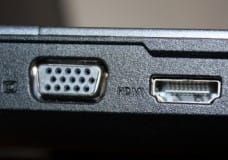Older Eyes
 Older Eyes: a reader asks…
Older Eyes: a reader asks…
Hi Chris, I’m 77 and have a Windows 10 laptop. My eyesight isn’t what it used to be and I’m having trouble seeing everything on my screen. I’m always losing where my mouse cursor is on the screen, and the text is so darn small that I can’t read easily. What can I do to make using my computer easier?
Don’t feel like it’s just you, most people over 40 have trouble seeing what’s on their screen, particularly as laptop screen sizes have diminished while their resolution or sharpness has gone up. The average laptop screen now measures only 14″ diagonally, and the resolution has increased so people can watch HD video (at 1920 by 1080 pixels) on that small screen. Before the HD video rage, screen resolutions were more like 1280 by 720, or even less. The lower the resolution, the larger everything on the screen is. What this means is that with a high-resolution screen, you don’t have to scroll as much to see things, but everything on the screen is much smaller. This plays havoc with everybody having to squint to make out the teeny-tiny icons and controls on a small laptop screen.
 Probably the first thing I’d suggest is to buy and connect a much larger external monitor. This only makes sense if a) money isn’t a factor, and b) if you mostly use the laptop in one spot at home, say a desk. I’m guessing your laptop screen is 13″-15″ in size, so a 24″ monitor will make everything twice as big. You can usually find one at your office or computer supply store for under $300. Two things to make sure of:
Probably the first thing I’d suggest is to buy and connect a much larger external monitor. This only makes sense if a) money isn’t a factor, and b) if you mostly use the laptop in one spot at home, say a desk. I’m guessing your laptop screen is 13″-15″ in size, so a 24″ monitor will make everything twice as big. You can usually find one at your office or computer supply store for under $300. Two things to make sure of:
- Make sure the monitor has the same connection type as the video output on your laptop – usually that’s either VGA (15 holes & pins) or HDMI (flat rectangle with a tongue and bottom corners chopped off). And that the monitor box includes the appropriate cable (if not, buy one while you’re at the store).
- Make sure your desk space is large enough to fit the dimensions of the external monitor you buy. So if you’ve room, feel free to go as large as you want!
If you’re stuck with the laptop screen, then there are some settings changes you can make to make things easier to see.
You can make mouse cursor settings changes to enlarge the size of the cursor, or even to temporarily enlarge it when you wiggle the mouse. To get there, click the Start button and type “mouse” then press your keyboard Enter key. Click on the Mouse & Touchpad settings to open a window. Scroll down to the bottom and click the ‘Additional mouse options’ link which opens a multi-tabbed window. On the Pointers and Pointer Options tabs you can adjust the way your cursor appears, make it larger, make it show trails, and more. In your case I’d suggest you do one or more of these three things:
- On the Pointers tab, choose the Scheme ‘Windows Black (extra large)(system scheme)’. This makes your pointer bolder and larger, therefore easier to see. Your options may be different, so just look for one that says large or extra large.
- On the Pointer Options tab, check the checkbox under Visibility to ‘Display pointer trails’.
- On the Pointer Options tab, check the checkbox under Visibility to ‘Show location of pointer when I press the CTRL key’ – apply that change and anytime you tap the CTRL key on your keyboard, you’ll see a big circle around the mouse.
For making text larger, you have a number of options. Probably the best for you is to change the display settings to make everything larger. Click Start > Settings > System and . You’ll see a slider to ‘Change the size of text, apps, and other items: 100%(Recommended)’. Drag the slider all the way to the right to increase the size of everything to 125%. You’ll probably have to sign out of Windows and back in to see the change in all apps and programs.
There are plenty of other settings changes you can make to improve display visibility for your particular situation, such as using high-contrast colors (a Windows theme change), using the built-in Windows Accessibility tools (such as Magnify), and changing the view in particular apps. Most web browsers have a Zoom feature that you can use to enlarge the size of everything on the web page, and other apps may have a way to change the magnification or zoom factor to make things appear larger. If you’ll tell me in the comments below what specific applications (and the version number of the application) you’re using where you’d like to see things larger, I can give you more specific instructions.
This website runs on a patronage model. If you find my answers of value, please consider supporting me by sending any dollar amount via:
or by mailing a check/cash to PosiTek.net LLC 1934 Old Gallows Road, Suite 350, Tysons Corner VA 22182. I am not a non-profit, but your support helps me to continue delivering advice and consumer technology support to the public. Thanks!






